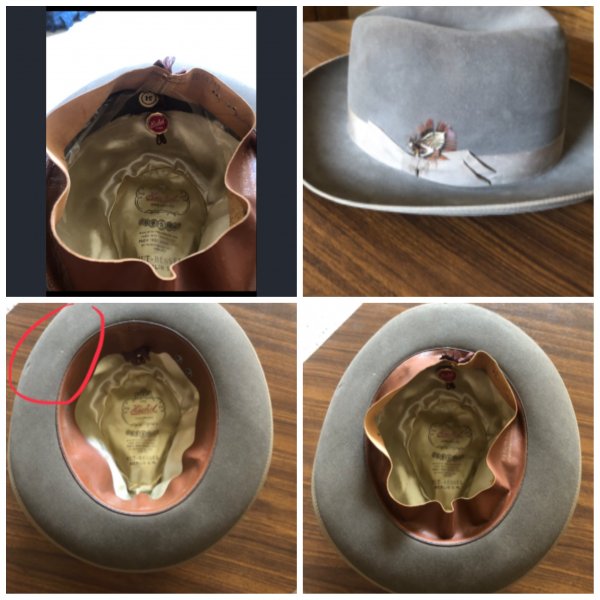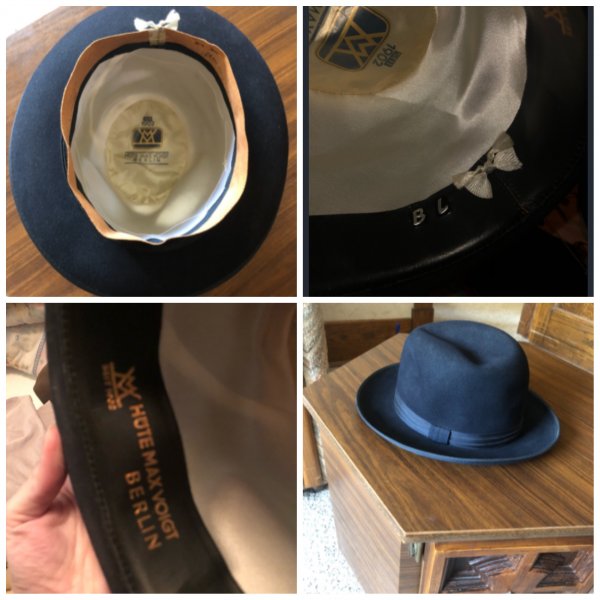Hat and Rehat
Call Me a Cab
- Messages
- 2,445
- Location
- Denver
I must admit a disconnect when I hear of folks removing the reed from their sweatband for comfort, as I have never considered it. I have never had an uncomfortable hat which was caused by the reed and no desire to second-guess the proper construction of the hat by the maker. Reeded sweats were, as I see it, introduced to allow for a bit more structure in the hat (allowing it to keep it's shape) and (I presume) a better production design that required less effort/labor to attach to the hat.
As to your hat which has shrunk, going from a 7 1/8 to 6 7/8 should result in warping of the leather sweatband, as having leather shrink to that degree unmolested would be highly unusual. Could it have had a new sweatband installed? And what do you mean by "shrink the flange?"
I wouldn't remove a reed for fit either. I have a pretty symetrical, regular oval head. Hats fit me well off the shelf, though I have tried some with gaps in an area or two. Imagine if your head was outside of the statistical norm though. It might be frustrating if you couldn't find a hat that fit without padding it out with foam or something every single time, or purchase only custom conformed hats for at least 5 times the price of off the shelf.
A reed, particularly a modern, plastic one, would probably extend the break in period of a standard hat to a custom head. That was why the question of non reeded hats was raised in thisvthread to begin with.
I think you're right about reeded sweats bringing down labor costs to a degree. Even the earliest machines could sew the leather to the reed tape, then a wide chain stitch could affix it to a hat by hand much faster than careful, close hand stitching around the perimeter of the crown. I'm less sure about it being to give a hat form or structure. Only those of us with standard heads might find that beneficial.
There's another benefit of reeded sweats though. The reed tape started as silk coated with something resistant to moisture, then evolved to a vinyl like fabric. When the system is sewn in correctly the tape functions as a barier to perspiration migrating from your head to the felt or straw. Without the reed and tape, sweat could move directly from the leather to the felt. With it, it could only move into the threads connecting tape and leather. Then completely different thread connects the tape to the felt, so there's no path from head to hat body. Of course, not all hatters seem to understand this feature of the design. They sew through the same holes to mount leather to tape and tape to hat body, which creates a path for perspiration to make it into the felt, via the threads.
I agree with your conclusion about felt and leather shrinking in unison. That's why I bought the hat on eBay even though the seller said it was really small, maybe 6 1/2, but used to be 7 1/8 (my size). The pictures didnt show a wavy connection, so I said, No Way the hat shrank that much! The leather wouldn't shrink equally with the felt.
It isn't 6 1/2. More like 6 7/8, which is still a size and a half. I'm having to do forensics in an attempt to figure it out.
The sweat gives every indication of being original. It's Stetson, embossed Stratoliner, and I believe Royal Deluxe (I'm out of town and can't check) and has an Arkansas store on the opposite side. The wear is consistent with an early Strat, and the fade lines after removing the skinny ribbon, as well as the thread securing it, say that it's original and unmolested. How do you replace a sweat without removing the band?
The reed tape at the underbrim is worn to the point of looking like woven fabric, with the coating gone. There's no reed, but there's vertigris at the back. That tells me there was once a ferule. The stitching between tape and felt was only done once, or someone took great care to use only the old holes, both basting and stitching to secure it.
If you have a conclusion other than it all being original I'd be interested to hear it.
My speculation runs this way. Someone became owner of the hat after the original owner. Maybe it was Dad's hat, but Son's head was smaller. The reed, usually stitched to ride just outside the flange, would have helped hold the hat away from junior's scull, so he clipped it at the ferule and pulled it out. Now the softer hat could be formed to his head easier. Maybe a pin or few stitches helped. Maybe a local hatter helped by protecting the leather while heat drying wet felt to shrink it. Maybe one even cut a little bit out of the leather at the seam and stitched it smaller, though he did it so nicely you can't tell, but nothing indicates this is true. Even the small bow seems to be stitched original. I suppose if the felt was successfully shrunk to a 6 7/8 from a 7 1/8, the leather might conform itself over time.
I dont know, and its still a mystery to some degree.
I plan to condition the leather then measure it and try to stretch it to 22 1/2. If it works I'd like to put that leather on a new tape with reed to keep it as original as possible. It separated from the old tape in places, but it was failed thread, not leather. Ill probably shave the top where the current holes are, about 1/8", then zig zag it with light tension so it can be turned out and back in. Maybe I'll even consider patching a little more leather in at the back seam, gluing fabric behind it for strength. Presently this is planned to remain a personal hat, but I purchased a Pilgrim OR clone that was sold by Sears at the same time as the Stratoliner. It's a very nice hat!
I heard good things about the JC Penny's hats, but nothing about the Sears, but the specimen I own is an equal to the Marathons I've handled.
Though, I digress from the original question about Stetson making non reeded hats.
Sent from my LGMP260 using Tapatalk








